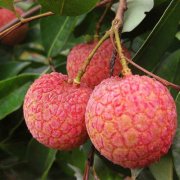When is the dormancy / flowering / fruiting period of medlar? When the temperature of Chinese wolfberry exceeds, it will go dormant.
The most commonly used medicinal part of Chinese wolfberry is the fruit, which is often called Chinese wolfberry, while the production and cultivation of Chinese wolfberry is almost concentrated in China, but only a small amount is cultivated in Taiwan at present. The prospect of planting Chinese wolfberry is still good.
Chinese wolfberry: sesame oil chicken, ginger mother duck and other traditional medicinal diet, you can often see the figure of Chinese wolfberry, small, red all over the body, it seems to taste a little sweet, but its function is not to cook soup, but has a powerful health care function, its plant is not only available fruit, including roots, stems and leaves, etc., the whole body is covered with treasures, as long as it is the Chinese world, all take it as a nourishing dietotherapy sacred.
Many people use pots to grow Chinese wolfberry by horticulture. Chinese wolfberry likes warm and moist soil, but when the temperature exceeds 30 degrees, it will dormant and dry. It can prune mature and aged branches, fry water for tea or stew to make soup. It has strong shade tolerance and can grow well in half a day.
The cutting period is 9 ∼ in April of the following year.
Choose old branches to survive easily, cut 6 ∼ 8 cm, leave 3 bud points, half into the medium, fully watered.
Dormant period 7 ∼ August
In the summer high temperature season, the leaves will stop growing, yellowing and shedding, and the plant will dry up and only branches will be left.
Flowering 9 ∼ December
The flowers begin to bloom purple and will soon turn yellowish, lasting about 2 ∼ for 3 days from flowering to shedding.
Fruit period 10 ∼ November
The young fruit is green at first, the fruit is about 0.9cm long, the growth period is about 22 ∼ 29 days, and turns red when ripe.
Harvest time 11 ∼ December
When the fruit turns bright red, it can be harvested. At this time, the fruit expands 1 ∼ twice as much as the young fruit, and the pulp becomes soft and juicy.

- Prev

Taiwan cantaloupe new variety Tairi hybrid, what are the characteristics of Kaohsiung No. 2 tangerine melon? how sweet is it?
The muskmelon "Kaohsiung No. 2-Orange Queen" in the mixed-race queen greenhouse of Taiwan and Japan has a sweet and delicious pulp and is easier to grow than those imported from Japan. Qingnong Su Jingwei has been successfully planted in Changzhi Township, Pingtung County. The agricultural reform farm in Kaohsiung District held a new variety demonstration and tasting meeting.
- Next

Introduction of common diseases and control methods of litchi trees, and effects of litchi diseases on litchi trees
Do you grow lychees? If you have planting, you must pay attention to the diseases and insect pests of litchi. Let's take a look at the common diseases of litchi. 1. Blight blight is caused by Peronophythora litchi, which can harm flower organs, leaves, tender stems and
Related
- The first cup of black tea in spring, the flavor and history of tea gardens in Kenya, Africa
- The computer can not only choose potatoes, but also grow tea rice. AI will grow winter oolong tea champion.
- It is not only the inflated tea bitten by insects, but also engraved with the four seasons tea in Beipu.
- The Oriental Beauty Tea Festival in Zhuxian County takes the stage at the weekend to experience the plus-size feast of oil tea.
- & quot; Oriental Beauty Tea & Exploration of Emei in Hsinchu, the hometown of quot;
- The new variety of strawberry "Tainong 1" dessert is the first choice with mellow aroma. Crimson gorgeous
- History of Tea in Taiwan: from Wild Inner Mountain to Export Tea Garden
- Two types of Taiwan Oriental Beauty Black Tea won the British three-Star Award for Childhood Tea Xiang Zhang Jiaqi changed from pilot to champion tea maker.
- Banana species and varieties: the planting history of Taiwan Xianren banana and dwarf banana is long, is banana disease resistant?
- Coffee planting Technology: Qianjie Coffee from Seedling to harvesting

